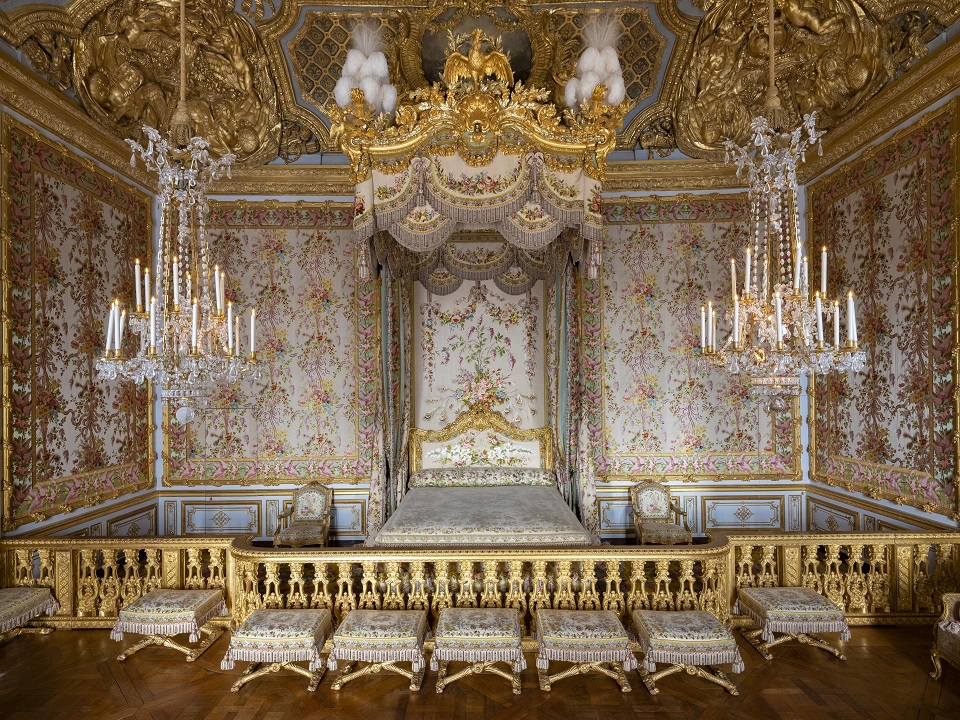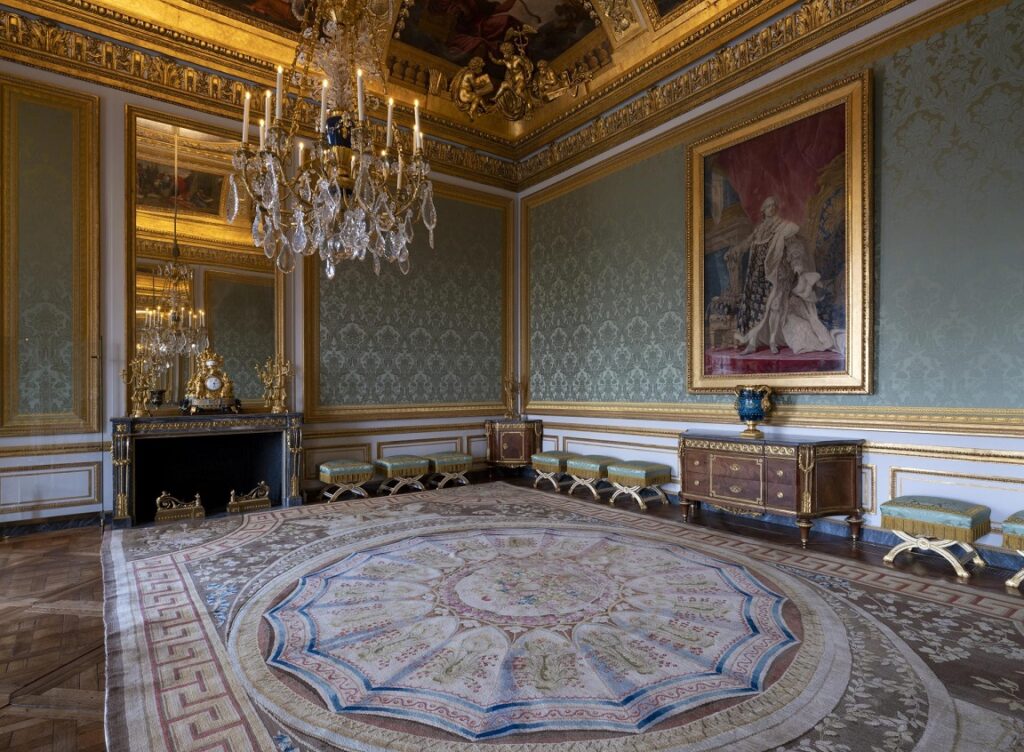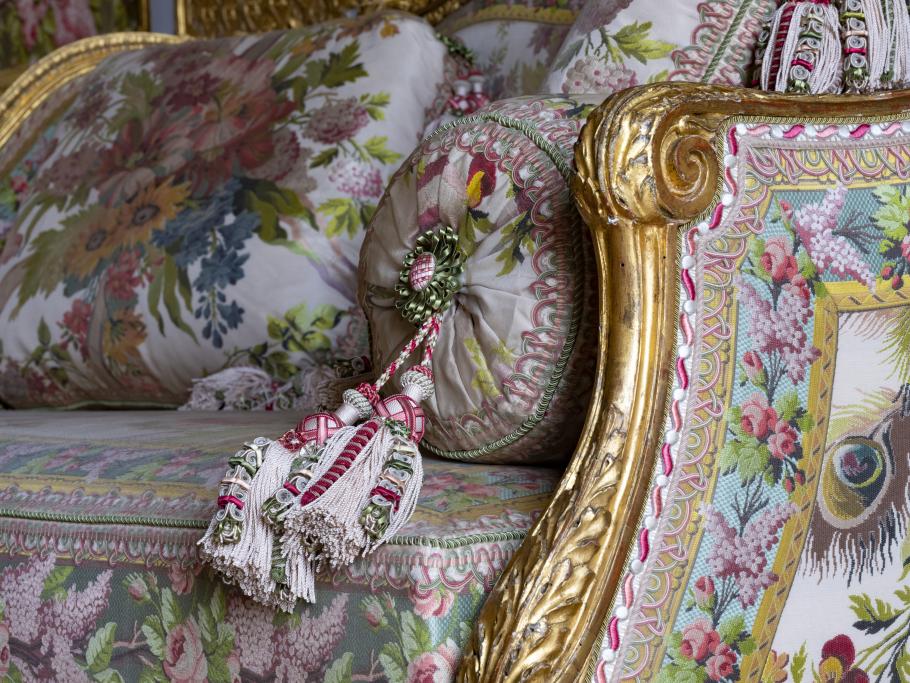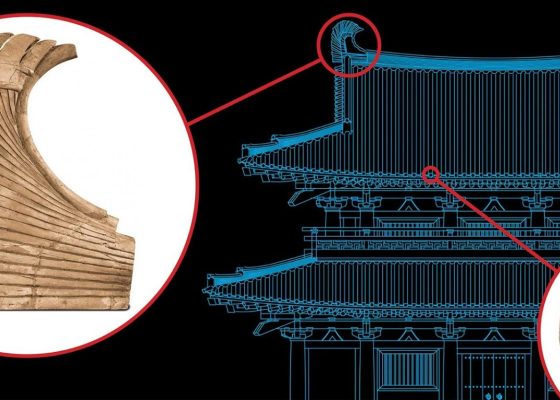
By Staff Middle Land
The Queen’s Apartments, which overlook the Midi Parterre, are a series of rooms whose layout is identical to that of the King’s State Apartments to the north. Queen Maria Theresa, Louis XIV’s wife, was the first person to live in these apartments, but she died not long after moving in, in 1683. The layout of the first floor of the Palace was perfectly symmetrical, with the north belonging to the king and the south to the queen. This was soon changed, however, by the king, who decided to set aside all the rooms around the Marble Courtyard for his new apartments. The queen’s space became limited to her State Apartments – which were modified by Marie Leszczyńska and later Marie-Antoinette – and to a few smaller rooms for more private use situated behind the official apartments, overlooking two inner courtyards.The current tour route passes through the rooms in the opposite direction to the traditional order, since it starts in the bedchamber and ends in the Queen’s Guard Room, which originally marked the entrance to the Queen’s Apartments during the Ancien Régime.
The Queen’s Bedchamber
The Bedchamber is the most important room in the apartments and is where the Queen spent most of her time. It was where she slept, often with the king, and in the morning she received guests here during and after her toilette which, like the King’s getting-up ceremony, was a courtly affair controlled by strict etiquette.
It was also here that the queen gave birth, in public, to the Princes and Princesses of the Realm. The word “public”, however, is misleading, since in reality very few people were admitted to the bedchamber while the queen was giving birth. Only doctors, ladies in waiting, the governess of the Princes and Princesses of the Realm, the Princesses of the royal family and a few members of the church were allowed to enter. The rest of the Court waited in the other rooms in the Apartment, whose doors were all symbolically left open. The queen was placed on a labour bed brought in specially, and was hidden behind a screen or canvas tent. After giving birth she was placed back in her own bed while the whole court filed through to present their compliments. Nineteen Princes and Princesses of the Realm were born here between 1682 and 1786, and two queens died here: Maria-Theresa in 1683 and Marie Leszczyńska in 1768.
The decoration in the room still reflects the three queens who once occupied it. The partitions on the ceiling date back to the reign of queen Maria-Theresa, while the greyscale painting by Boucher and the wood panelling were added for Marie Leszczyńska. These elements survived the reign of Marie-Antoinette, who replaced the furniture and fireplace and put up paintings of her mother Empress Maria-Theresa and her brother, Emperor Joseph II.
The jewellery cabinet commissioned to Schwerdfeger by Marie-Antoinette has been placed in its original position in the alcove to the left of the bed. Other pieces of furniture which were lost have been replaced by similar items, such as the sofa delivered for the Countess of Provence, the queen’s sister-in-law. The fabrics hanging on the bed and walls were re-woven in Lyon using the original patterns and the bed and balustrade have been remade using ancient documents.

The Royal Table Antechamber
Traditionally, public meals at the Royal Table, taken by the king and the royal family, were held in the Queen’s Antechamber. This lavish ceremony attracted a large number of curious onlookers. Only the members of the royal family were allowed to dine, while privileged duchesses, princesses or those holding important positions sat in front them on stools, and the other ladies and people whose rank granted them entry or who were admitted by the ushers stood around them. Louis XIV adhered strictly to this ceremonial performance almost every evening, whereas Louis XV more often preferred private dinners and Louis XVI and Marie-Antoinette only ate at the Royal Table once a week. One account at the time reported that “the King ate heartily, but the Queen didn’t even remove her gloves or unfold her serviette, which was a great mistake”. To brighten up what she considered to be a great chore, Marie-Antoinette requested that music was played during meals at the Royal Table, and a platform for musicians was installed in the room to this end.
The Queen’s Royal Table Antechamber was restaured between 2009-2010 thanks to sponsorshipf from Martell & Co.

The Queen’s Guard Room
Entry to the Queen’s Apartments from the Queen’s Staircase, also called the “Marble Staircase”, was controlled by the Guard Room, where 12 of the Queen’s Guards were on duty day and night. At Versailles only the king, queen and dauphin were allowed to have a personal guard composed of soldiers from the four elite companies of the King’s Guards. The large adjoining room, today called the “Coronation Room”, was assigned to them and served as a Guardhouse.
The Queen’s Guard Room is the only room in the Apartments in which the 17th-century decoration has been fully preserved, since the Queen never spent time here and there was therefore no need to modernise it. For this reason, it still contains the marble panelling characteristic of the State Apartments’ original condition, as well as the paintings which were brought here in 1680 from the old Jupiter Room, later replaced by the War Room.
It was also here that a group of rioters tried to enter the Queen’s Apartments at dawn on 6 October 1789. One of the ladies in waiting was warned by one of the queen’s guards and managed to bolt the door to the Royal Table Antechamber and help the queen hurry through to the king’s apartments via her private chambers.












Cancel anytime


Using our website
You may use the The Middle Land website subject to the Terms and Conditions set out on this page. Visit this page regularly to check the latest Terms and Conditions. Access and use of this site constitutes your acceptance of the Terms and Conditions in-force at the time of use.
Intellectual property
Names, images and logos displayed on this site that identify The Middle Land are the intellectual property of New San Cai Inc. Copying any of this material is not permitted without prior written approval from the owner of the relevant intellectual property rights.
Requests for such approval should be directed to the competition committee.
Please provide details of your intended use of the relevant material and include your contact details including name, address, telephone number, fax number and email.
Linking policy
You do not have to ask permission to link directly to pages hosted on this website. However, we do not permit our pages to be loaded directly into frames on your website. Our pages must load into the user’s entire window.
The Middle Land is not responsible for the contents or reliability of any site to which it is hyperlinked and does not necessarily endorse the views expressed within them. Linking to or from this site should not be taken as endorsement of any kind. We cannot guarantee that these links will work all the time and have no control over the availability of the linked pages.
Submissions
All information, data, text, graphics or any other materials whatsoever uploaded or transmitted by you is your sole responsibility. This means that you are entirely responsible for all content you upload, post, email or otherwise transmit to the The Middle Land website.
Virus protection
We make every effort to check and test material at all stages of production. It is always recommended to run an anti-virus program on all material downloaded from the Internet. We cannot accept any responsibility for any loss, disruption or damage to your data or computer system, which may occur while using material derived from this website.
Disclaimer
The website is provided ‘as is’, without any representation or endorsement made, and without warranty of any kind whether express or implied.
Your use of any information or materials on this website is entirely at your own risk, for which we shall not be liable. It is your responsibility to ensure any products, services or information available through this website meet your specific requirements.
We do not warrant the operation of this site will be uninterrupted or error free, that defects will be corrected, or that this site or the server that makes it available are free of viruses or represent the full functionality, accuracy and reliability of the materials. In no event will we be liable for any loss or damage including, without limitation, loss of profits, indirect or consequential loss or damage, or any loss or damages whatsoever arising from the use, or loss of data, arising out of – or in connection with – the use of this website.
Last Updated: September 11, 2024
New San Cai Inc. (hereinafter “The Middle Land,” “we,” “us,” or “our”) owns and operates www.themiddleland.com, its affiliated websites and applications (our “Sites”), and provides related products, services, newsletters, and other offerings (together with the Sites, our “Services”) to art lovers and visitors around the world.
This Privacy Policy (the “Policy”) is intended to provide you with information on how we collect, use, and share your personal data. We process personal data from visitors of our Sites, users of our Services, readers or bloggers (collectively, “you” or “your”). Personal data is any information about you. This Policy also describes your choices regarding use, access, and correction of your personal information.
If after reading this Policy you have additional questions or would like further information, please email at middleland@protonmail.com.
PERSONAL DATA WE COLLECT AND HOW WE USE IT
We collect and process personal data only for lawful reasons, such as our legitimate business interests, your consent, or to fulfill our legal or contractual obligations.
Information You Provide to Us
Most of the information Join Talents collects is provided by you voluntarily while using our Services. We do not request highly sensitive data, such as health or medical information, racial or ethnic origin, political opinions, religious or philosophical beliefs, trade union membership, etc. and we ask that you refrain from sending us any such information.
Here are the types of personal data that you voluntarily provide to us:
As a registered users or customers, you may ask us to review or retrieve emails sent to your business. We will access these emails to provide these services for you.
We use the personal data you provide to us for the following business purposes:
Information Obtained from Third-Party Sources
We collect and publish biographical and other information about users, which we use to promote the articles and our bloggers who use our sites. If you provide personal information about others, or if others give us your information, we will only use that information for the specific reason for which it was provided.
Information We Collect by Automated Means
Log Files
The site uses your IP address to help diagnose server problems, and to administer our website. We use your IP addresses to analyze trends and gather broad demographic information for aggregate use.
Every time you access our Site, some data is temporarily stored and processed in a log file, such as your IP addresses, the browser types, the operating systems, the recalled page, or the date and time of the recall. This data is only evaluated for statistical purposes, such as to help us diagnose problems with our servers, to administer our sites, or to improve our Services.
Do Not Track
Your browser or device may include “Do Not Track” functionality. Our information collection and disclosure practices, and the choices that we provide to customers, will continue to operate as described in this Privacy Policy, whether or not a “Do Not Track” signal is received.
HOW WE SHARE YOUR INFORMATION
We may share your personal data with third parties only in the ways that are described in this Privacy Policy. We do not sell, rent, or lease your personal data to third parties, and We does not transfer your personal data to third parties for their direct marketing purposes.
We may share your personal data with third parties as follows:
There may be other instances where we share your personal data with third parties based on your consent.
HOW WE STORE AND SECURE YOUR INFORMATION
We retain your information for as long as your account is active or as needed to provide you Services. If you wish to cancel your account, please contact us middleland@protonmail.com. We will retain and use your personal data as necessary to comply with legal obligations, resolve disputes, and enforce our agreements.
All you and our data are stored in the server in the United States, we do not sales or transfer your personal data to the third party. All information you provide is stored on a secure server, and we generally accepted industry standards to protect the personal data we process both during transmission and once received.
YOUR RIGHTS/OPT OUT
You may correct, update, amend, delete/remove, or deactivate your account and personal data by making the change on your Blog on www.themiddleland.com or by emailing middleland@protonmail.com. We will respond to your request within a reasonable timeframe.
You may choose to stop receiving Join Talents newsletters or marketing emails at any time by following the unsubscribe instructions included in those communications, or you can email us at middleland@protonmail.com
LINKS TO OTHER WEBSITES
The Middle Land include links to other websites whose privacy practices may differ from that of ours. If you submit personal data to any of those sites, your information is governed by their privacy statements. We encourage you to carefully read the Privacy Policy of any website you visit.
NOTE TO PARENTS OR GUARDIANS
Our Services are not intended for use by children, and we do not knowingly or intentionally solicit data from or market to children under the age of 18. We reserve the right to delete the child’s information and the child’s registration on the Sites.
PRIVACY POLICY CHANGES
We may update this Privacy Policy to reflect changes to our personal data processing practices. If any material changes are made, we will notify you on the Sites prior to the change becoming effective. You are encouraged to periodically review this Policy.
HOW TO CONTACT US
If you have any questions about our Privacy Policy, please email middleland@protonmail.com
The Michelin brothers created the guide, which included information like maps, car mechanics listings, hotels and petrol stations across France to spur demand.
The guide began to award stars to fine dining restaurants in 1926.
At first, they offered just one star, the concept was expanded in 1931 to include one, two and three stars. One star establishments represent a “very good restaurant in its category”. Two honour “excellent cooking, worth a detour” and three reward “exceptional cuisine, worth a
Thank you for your participation,
please Log in or Sign up to Vote

123Sign in to your account